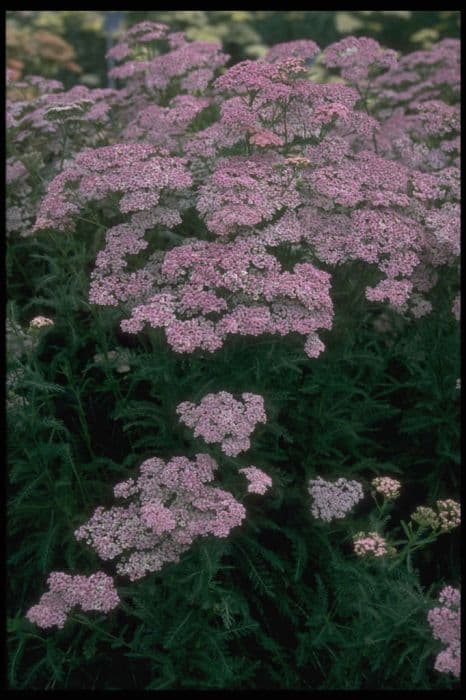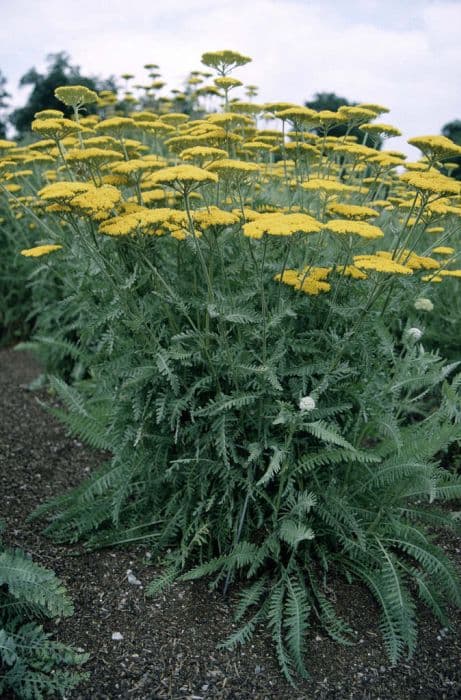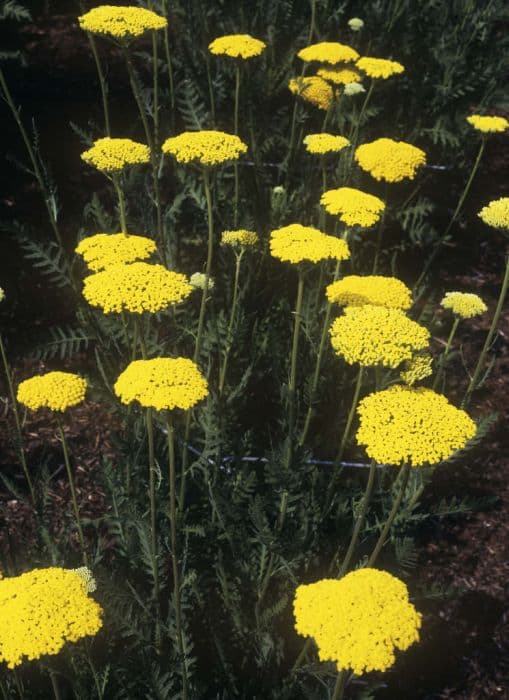Tickseed Coreopsis 'Rum Punch' (PBR) (Punch Series)

ABOUT
Coreopsis 'Rum Punch' is an ornamental plant that is part of the Punch Series. It is admired for its vibrant and colorful flowers. This variety of Coreopsis often bears striking blooms that have a warm, radiant hue. The flowers typically showcase a rich gradation of color, with deep red at the center that fades out to a cheerful, bright orange or yellow towards the petal edges, resembling the shades found in a tropical rum punch beverage, giving the plant its distinctive name. The blossoms generally have a daisy-like form, which is characteristic of the Coreopsis genus, with a central disk surrounded by an array of petals. The central disk is often a darker shade, contrasting with the lighter tips, and can appear almost burgundy or brownish-red, adding depth and dimension to the flower's appearance. The leaves of 'Rum Punch' are slender and elongated with jagged edges, adding a delicate texture to the plant. They are often a deep green, which helps highlight the bright colors of the flowers. The contrast between the foliage and the blooms creates a striking presentation in the garden or when used as a cut flower in floral arrangements. Overall, Coreopsis 'Rum Punch' flowers continuously throughout the blooming season, attracting pollinators such as bees and butterflies with their vivid coloring and nectar-rich centers. Despite the exclusion of the physical dimensions, this perennial is a compact and bushy plant, filling out its space with abundant blooms and rich foliage. It is typically grown for its ornamental value and is a popular choice for borders, containers, and as a vibrant addition to any flower bed.
About this plant
 Names
NamesFamily
Asteraceae
Synonyms
Tickseed, Pot of Gold
Common names
Coreopsis 'Rum Punch' (PBR) (Punch Series).
 Toxicity
ToxicityTo humans
Coreopsis, commonly known as tickseed, is generally not considered to be toxic to humans. There are no well-documented reports of Coreopsis 'Rum Punch' causing poisoning in humans, and the plant is typically seen as safe to grow in gardens where it might be accessible to adults and children. However, as a general precaution, it is still advisable to avoid ingesting any part of ornamental plants as they are not meant for consumption and individual sensitivities or allergic reactions could potentially occur.
To pets
Tickseed, including Coreopsis 'Rum Punch', is not known to be toxic to pets such as dogs and cats. It is generally considered safe for gardens that are frequented by pets. While it is not intended for consumption and ingestion of large quantities may cause mild gastrointestinal upset due to the plant matter itself, there are no specific toxic principles in Coreopsis 'Rum Punch' that would lead to poisoning symptoms in pets. Nonetheless, to prevent any possible upset, it is advisable to discourage pets from eating garden plants.
 Characteristics
CharacteristicsLife cycle
Perennials
Foliage type
Deciduous
Color of leaves
Green
Flower color
Mixed
Height
1-2 feet (30-60 cm)
Spread
1-2 feet (30-60 cm)
Plant type
Herb
Hardiness zones
5
Native area
North America
Benefits
 General Benefits
General Benefits- Attracts Pollinators: Coreopsis 'Rum Punch' draws bees, butterflies, and other beneficial insects, aiding in pollination and promoting biodiversity.
- Low Maintenance: This plant requires minimal care once established, making it a great choice for gardeners of all levels.
- Drought Tolerant: Adapted to survive with limited water, making it an ideal plant for dry climates or water-wise gardens.
- Long Blooming Season: Offers a long-lasting display of vibrant flowers typically from early summer into the fall.
- Deer Resistant: Generally not preferred by deer, which helps prevent damage to the plant in areas with deer populations.
- Landscape Versatility: It can be used in various garden settings such as borders, containers, and as a mass planting for visual impact.
- Colorful Foliage: The foliage of Coreopsis 'Rum Punch' may offer visual interest even when the plant is not in bloom.
 Medical Properties
Medical PropertiesThis plant is not used for medical purposes.
 Air-purifying Qualities
Air-purifying QualitiesThis plant is not specifically known for air purifying qualities.
 Other Uses
Other Uses- Natural fabric dye: The bright, colorful flowers of Coreopsis can be used to create a natural dye for fabrics, offering hues ranging from orange to rusty red.
- Photography subject: With its vibrant flowers, Coreopsis serves as an excellent subject for photographers, especially those interested in capturing the beauty of gardens and plants.
- Craft projects: The dried flowers of Coreopsis can be used in a variety of craft projects, including making bookmarks, greeting cards, or for flower pressing activities.
- Garden art: The sturdy stems and bright flowers can become part of garden art installations, complementing sculptures, or being utilized in living walls.
- Education: Coreopsis can be used in educational settings for plant biology lessons, highlighting plant structure, pollination, and the lifecycle of a flowering plant.
- Festive decorations: The flowers can be used to create natural, biodegradable decorations for festivals or garden parties, giving a vibrant look that blends in with the outdoor setting.
- Eco-printing: The leaves and flowers of Coreopsis can be used for eco-printing, a method of transferring plant pigments directly onto fabric or paper to create patterns and designs.
- Sensory gardens: Coreopsis 'Rum Punch' provides both visual appeal and a soft texture, making it suitable for sensory garden experiences, particularly for those with visual impairments or as a tactile plant for children.
- Nature-themed events: Flowers from Coreopsis can be used as confetti or to create a natural aisle for outdoor weddings and other nature-themed events.
- Seed sharing: Enthusiasts of Coreopsis can collect the plant's seeds and use them in seed exchange programs with other gardeners to promote biodiversity and the sharing of garden resources.
Interesting Facts
 Feng Shui
Feng ShuiThe Coreopsis is not used in Feng Shui practice.
 Zodiac Sign Compitability
Zodiac Sign CompitabilityThe Coreopsis is not used in astrology practice.
 Plant Symbolism
Plant Symbolism- Optimism: Coreopsis, commonly known as Tickseed, is often associated with cheerfulness and optimism due to its bright and sunny flowers, conveying a sense of positivity and good energy.
- Love: The vibrant colors of Tickseed can represent feelings of love and affection, making it a wonderful gift to express these emotions.
- Good Fortune: Tickseed is sometimes believed to bring good luck to those who plant it or have it within their home, symbolizing prosperity and a bright future.
 Water
WaterThe proper care for Tickseed involves watering it deeply once a week, allowing the water to penetrate the soil to encourage deep root growth. During periods of intense heat or drought, you may need to increase the frequency to twice a week. Ensure that the plant receives around 1-1.5 gallons each time you water, depending on soil type and weather conditions. Always check the soil moisture before watering—Tickseed prefers to dry out slightly between waterings. It's vital to avoid overwatering, as this can lead to root rot.
 Light
LightTickseed thrives best in full sun conditions, where it can receive at least 6 to 8 hours of direct sunlight per day. The plant will produce the most abundant blooms in a bright spot that receives unfiltered sunlight throughout the day. However, in very hot climates, some afternoon shade is beneficial to prevent scorching.
 Temperature
TemperatureTickseed can tolerate a range of temperatures and is generally hardy in USDA zones 4 to 9. The plant can survive minimum temperatures down to around -30°F and is comfortable in the heat up to about 90°F. The ideal growing temperature for Tickseed is between 60°F and 70°F.
 Pruning
PruningPruning Tickseed helps to promote vigorous growth and abundant flowering. Deadheading, or removing spent flowers, should be done regularly throughout the blooming season to encourage more blooms. Additionally, cutting back the plant by one third in mid to late summer can rejuvenate the foliage and stimulate a fresh flush of flowers. The best time for a major prune is in late winter or early spring before new growth appears.
 Soil
SoilTickseed 'Rum Punch' thrives in well-draining soil with a pH between 5.8 and 6.8. A mix of loamy soil enriched with compost and perlite or sand is ideal to ensure adequate drainage and provide necessary nutrients. Regular amending with organic matter can help maintain soil health.
 Repotting
RepottingTickseed 'Rum Punch' does not need frequent repotting and can be repotted every 2 to 3 years to refresh the soil. Ensure that the new pot has adequate drainage holes to prevent waterlogging.
 Humidity & Misting
Humidity & MistingTickseed 'Rum Punch' is tolerant of a wide range of humidity levels and does not require specific humidity conditions to thrive, making it suitable for a variety of outdoor garden settings.
 Suitable locations
Suitable locationsIndoor
Ensure bright light and well-draining soil mix.
Outdoor
Plant in full sun with good drainage.
Hardiness zone
5-9 USDA
 Life cycle
Life cycleCoreopsis 'Rum Punch', commonly known as Tickseed, begins its life as a seed, which germinates in early to mid-spring when soil temperatures warm up. After sprouting, the seedling grows rapidly, developing a rosette of leaves at the soil level. During late spring to early summer, the Tickseed enters the vegetative stage and starts to produce sturdy stems and more intricate leaf structures. By mid-summer, the plant reaches the flowering stage, showcasing vibrant, daisy-like blooms that attract pollinators and can continue to flower into fall if deadheaded regularly. As temperatures drop in late fall, Coreopsis 'Rum Punch' may die back, with the above-ground growth going dormant while the root system remains alive. The plant can then regrow from these roots the following spring, completing its perennial life cycle.
 Propogation
PropogationPropogation time
Spring-Early Summer
Coreopsis 'Rum Punch', commonly known as Tickseed, is typically propagated by division, which is the most popular method for this perennial plant. Propagation by division is best performed in the spring or early fall, when the plant is not in peak bloom. This process involves digging up an established clump of Tickseed and gently separating it into smaller sections, each with a portion of the root system and several shoots. These divisions can then be replanted immediately at the same depth they were originally growing, spaced approximately 12 to 18 inches (30 to 45 centimeters) apart to allow room for growth. Water the new divisions thoroughly to help establish the root system and maintain moisture levels, especially during the first few weeks after planting. This method of propagation can rapidly increase your stock of plants while also rejuvenating older clumps that may have become woody or less vigorous.









